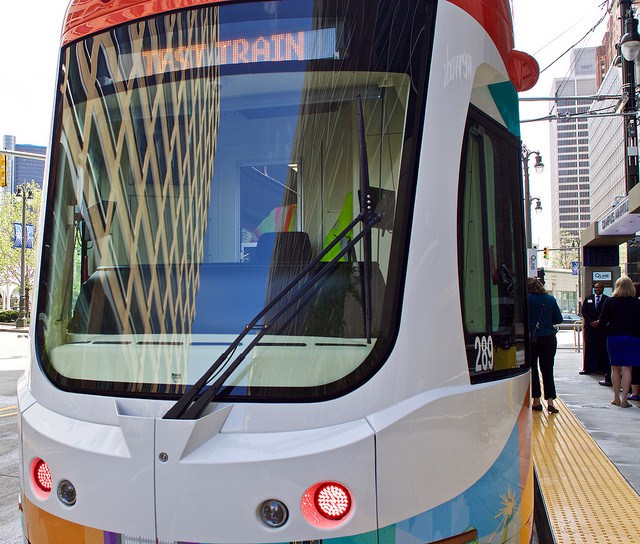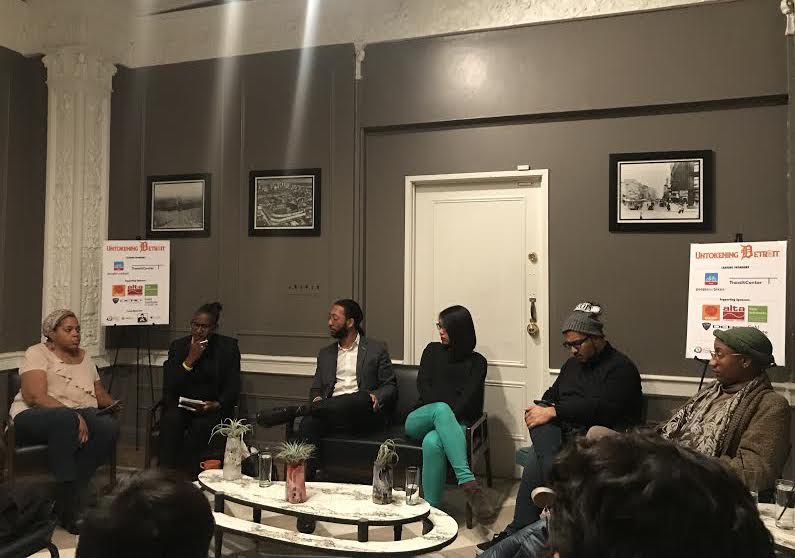Mobility justice advocates gathered in Detroit last weekend for the third annual convening of The Untokening, a multiracial collective centering the lived experiences of marginalized communities to address mobility justice and equity.
On Saturday night a "Cross-City Conversation" at a local pub focused on the experiences of Detroit transit riders. Panelists included Oneita Jackson, a local resident and former Detroit Free Press columnist; Renard Monczunski, an organizer with the Detroit People’s Platform; Eric Thomas, a brand strategist and senior partner at Detroit-based Saga Marketing; Bree Gant, a multidisciplinary artist from Detroit; and Grace Kyung, special projects director at Trailnet; and moderator Biba Adams, a Detroit-based writer.
Thomas, a native Detroiter, talked about his frustrating experiences riding the bus in the Motor City. One of the final straws was when he started a new job in a location where commuting by bus took two hours each way. “I would sometimes walk home,” he said. “This would have been a 15 minute car ride.” Thomas said he no longer takes transit in Detroit. “The bus made me stop riding the bus.”
When transit riders face hardships, it can be difficult to figure out where to focus those frustrations. Jackson posed the question, “Whose responsibility is it to have expectations for our transit?” As a bus rider, she said she frequently talks to the people on the bus about their experiences. “We have the same complaints about the bus and expectations that aren’t met,” she said. She noted that many Detroiters rely on buses to get around, but service is infrequent and unreliable.
Likewise, Gant noted the value of talking to people on the bus. “Engagement on the bus is a lot greater than in other spaces," she said. "It’s sometimes the type of acknowledgment of each other on the bus that you don’t see often and is a reprieve from gentrification.”
Monczunski described how Detroit's Transit Justice Team has organized and advocated for better service, which is especially important in a city that downplays the complaints of Black residents. He added that one factor that complicates transit advocacy is “transit gentrification,” the phenomenon of transit funding being used for projects that largely help real estate developers and wealthier newcomers, rather than benefitting current residents who rely on public transportation.
As an example, he discussed the $140 million QLine streetcar, which opened last year on a 3.3-mile stretch of Woodward Avenue in downtown and midtown Detroit. Boosters had argued that it would spur economic development, but the slow-moving streetcars, which share a curbside lane with other vehicles, only see a few thousand riders per day along the short route. That does little to address the transportation needs of everyday Detroiters. Meanwhile shortly before the line opened, voters in the region narrowly rejected a ballot measure to fund a cohesive regional transit system, which would have helped connect Detroit residents with jobs.

Thomas echoed Monczunski’s thoughts about the streetcar, arguing that the QLine was designed to benefit the well-connected, but simply investing in better Woodward Avenue bus service would have benefitted more residents. “The QLine doesn’t solve any problem, except property value problems. The QLine is about commerce, but the city pretends it’s about transit and mobility.”
Jackson said one of the core barriers to advocating for better bus service is the fact that bus riders aren’t taken seriously. “What are the perceptions about buses and who is framing these perceptions?” she asked. "Do those people actually ride the bus?"
Monczunski added that, while bus service is inadequate, a potential fare increase is on the horizon. “How are we going to pay more when it is an inefficient system?”
He argued that to push for change, it’s important to note the intersections between transportation issues and other social justice issues. “Transit justice is housing justice is social justice. You cannot have social justice without having transit justice.”
Gant reiterated this idea. “[Being on the bus in Detroit] was the first time I saw a lot of different forms of intersecting oppressions. Magic happens there. It was the first time I felt hopeful.”
Thomas noted that lackluster transit is tied to disempowerment. He said Detroit is a metaphor for the Blackest, most oppressed city. “We had our dignity stolen, in addition to our transit.”
Thomas added social justice is about helping people regain their self-worth. “We need to expect more,” he said. “Detroit has become the place to come to, not the place to stay,” referring to the gentrification of downtown but continual disinvestment from neighborhoods.
Kyung said part of social justice work is uplifting each other’s work. She highlighted People for Mobility Justice in Los Angeles and their efforts to reimagine mobility justice beyond the Vision Zero crash prevention movement. The group recently unveiled its 5 D’s for mobility justice: "Decolonize, Decongest, Decriminalize, Dignify, and Determination."
Monczunski said that to create a truly equitable transportation system, transit riders need to be at the decision-making table, and transportation staffers need to make choices based on the needs of residents, not the desires of the well-connected. “We also need to heal the relationship between riders and bus drivers.”
An audience member asked the panelists what's needed to bring about systemic change for transportation justice. “Let’s make transit free," Kyung responded. "It should be a free commodity. That’s how we’re going to get change system-wide.”
![]()
Did you appreciate this post? Consider making a donation through our PublicGood site.





